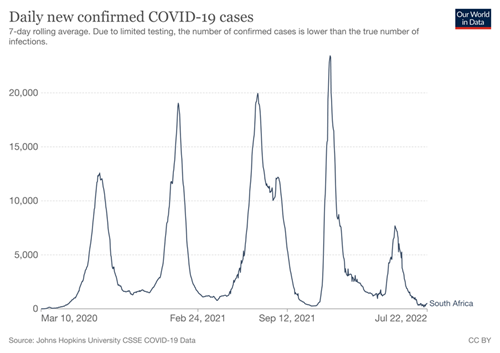
South African life insurers reported a significant drop in death claims for the six months to the end of March 2022 when compared to previous six monthly reporting periods since the start of the COVID-19 pandemic. South Africa experienced the fourth wave of COVID-19 infections during December 2021, which peaked during the middle of that month.
The Association for Savings and Investment South Africa (ASISA) started tracking death claims against individual life, group life (offered by employers), credit life and funeral cover policies at the start of April 2020 to measure the impact of the COVID-19 pandemic on the long-term insurance industry. South Africa announced its first COVID-19 case on 5 March 2020 and the first COVID-19 death was reported on 27 March 2020.
 Commenting on the death claims statistics released by ASISA today, Hennie de Villiers, deputy chair of the ASISA Life and Risk Board Committee, says while the actual number of reported COVID-19 cases was much higher during the fourth wave when compared to the first three waves, the number of death claims processed by life insurers during this period was significantly lower.
Commenting on the death claims statistics released by ASISA today, Hennie de Villiers, deputy chair of the ASISA Life and Risk Board Committee, says while the actual number of reported COVID-19 cases was much higher during the fourth wave when compared to the first three waves, the number of death claims processed by life insurers during this period was significantly lower.
“We believe that the death rate during the fourth wave was lower because on average infections caused by the Omicron variant were milder, more people had been vaccinated and a significant number of people had pre-existing immunity due to previous infections.”
The six-month death claims statistics show that 396 698 claims were received between 1 October 2021 and 31 March 2022 to a value of R28.5 billion.
“This is a significant drop from the more than half a million death claims received during the previous six month period, which included the third wave. The most recent numbers are also closer to the 333 509 death claims received in the six months preceding the pandemic.”
The table below compares the death claims paid for the six months to the end of March 2022, which include the fourth wave, to the previous six month period, which includes the third wave. The table also details the death claims paid over the six months before the COVID-19 pandemic took off in South Africa.
Death claims and benefits paid:
* The fourth COVID-19 wave ran from the first week of December 2020 to the end of December 2021 and peaked during the middle of December.
** The third COVID-19 wave ran from the first week of May 2021 to the middle of September 2021 and peaked in the middle of July 2021.
*** SA announced its first COVID-19 case on 5 March 2020 and the first COVID-19 death was reported on 27 March 2020.
According to De Villiers, a total of 1 985 303 death claims was received in the 24 months from 1 April 2020 to 31 March 2022. Life insurers paid out benefits of R120.5 billion to the beneficiaries who submitted these death claims.
He says that while not every death for which claims were submitted had been caused by COVID-19, there is no doubt that the pandemic has been responsible for many of the additional deaths. “This could be directly as a result of a person contracting the virus or because people were reluctant or unable to seek medical attention for other serious conditions.”
De Villiers cautions against complacency: “While the death rate was lower during the fourth wave than in previous waves, the number of death claims was still almost 20% higher than in the corresponding pre-pandemic period. Only around 50% of our adult population has been vaccinated and future variants may emerge as more aggressive.”
A case for risk cover
De Villiers points out that with almost two million life policies paying out in excess of R120.5 billion in the two years since COVID-19 arrived in South Africa, many families received much-needed financial assistance following the devastating loss of a loved one. As a result of COVID-19, many lives were lost at a time when the pandemic also resulted in massive job losses and the country’s economy was struggling.
He explains that life altering events like death, disability and critical illness cannot be timed or predicted. “Therefore, the best time to put in place sufficient cover to help your family survive financially in a time of need is while you are healthy and able to qualify for cover at affordable rates and without exclusions. Also, if you already have cover it is of utmost importance that you continue paying your premiums so that you remain covered. If you let your policy lapse you may not be able to secure cover at the same rates – or not at all - when you apply for it again.”
De Villiers adds that unfortunately many people underestimate the financial impact on their families when a breadwinner dies or becomes disabled.
De Villiers says despite the significant increase in claims paid as a result of the Covid-19 pandemic, the life insurance industry remains resilient and able to support its policyholders and their beneficiaries throughout this difficult time and beyond.
De Villiers says the South African life insurance industry held assets of R3.71 trillion at the end of 2021, while liabilities amounted to R3.36 trillion. This left the industry with free assets of R350.5 billion, which is just under double the capital required by the Solvency Capital Requirements (SCR).